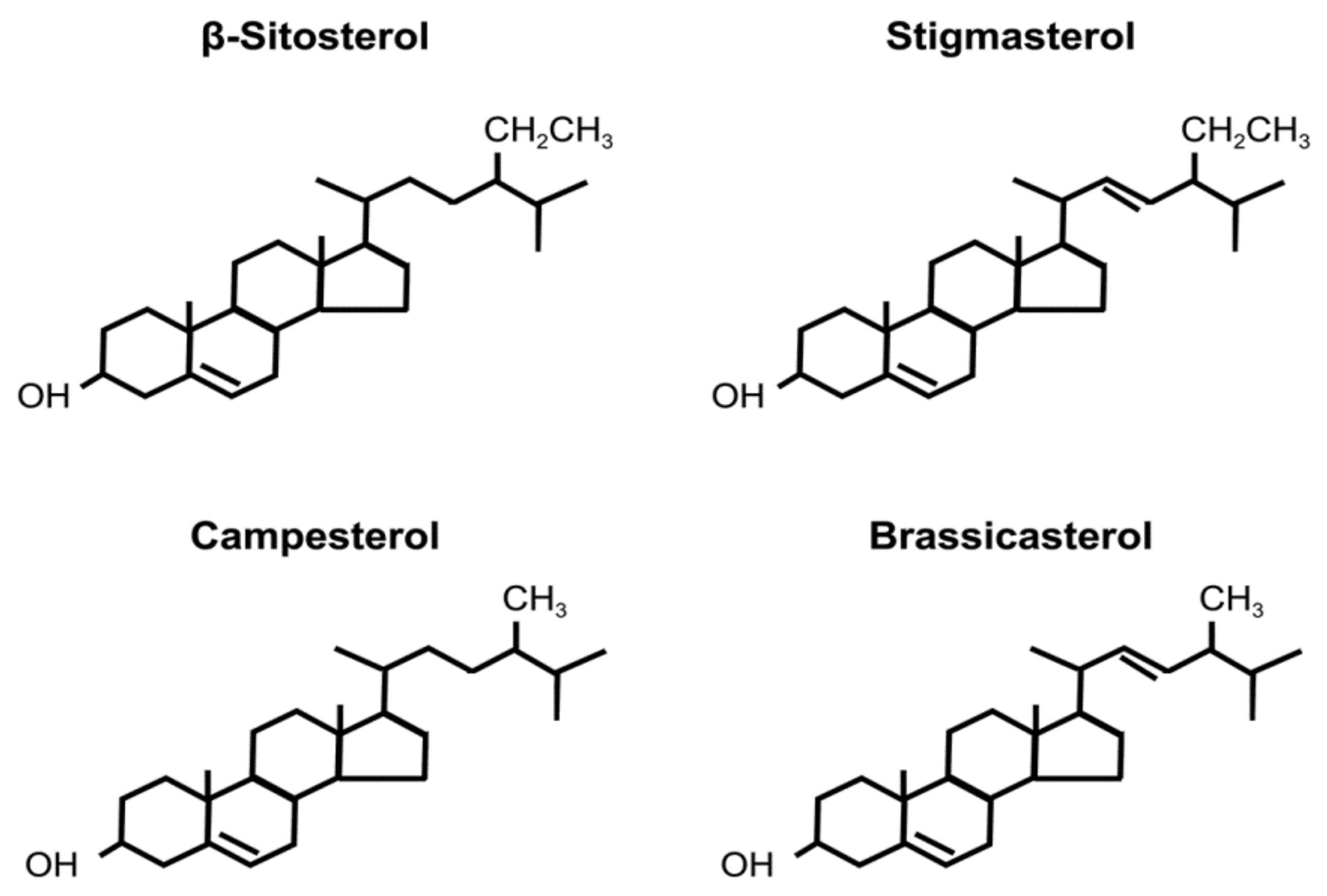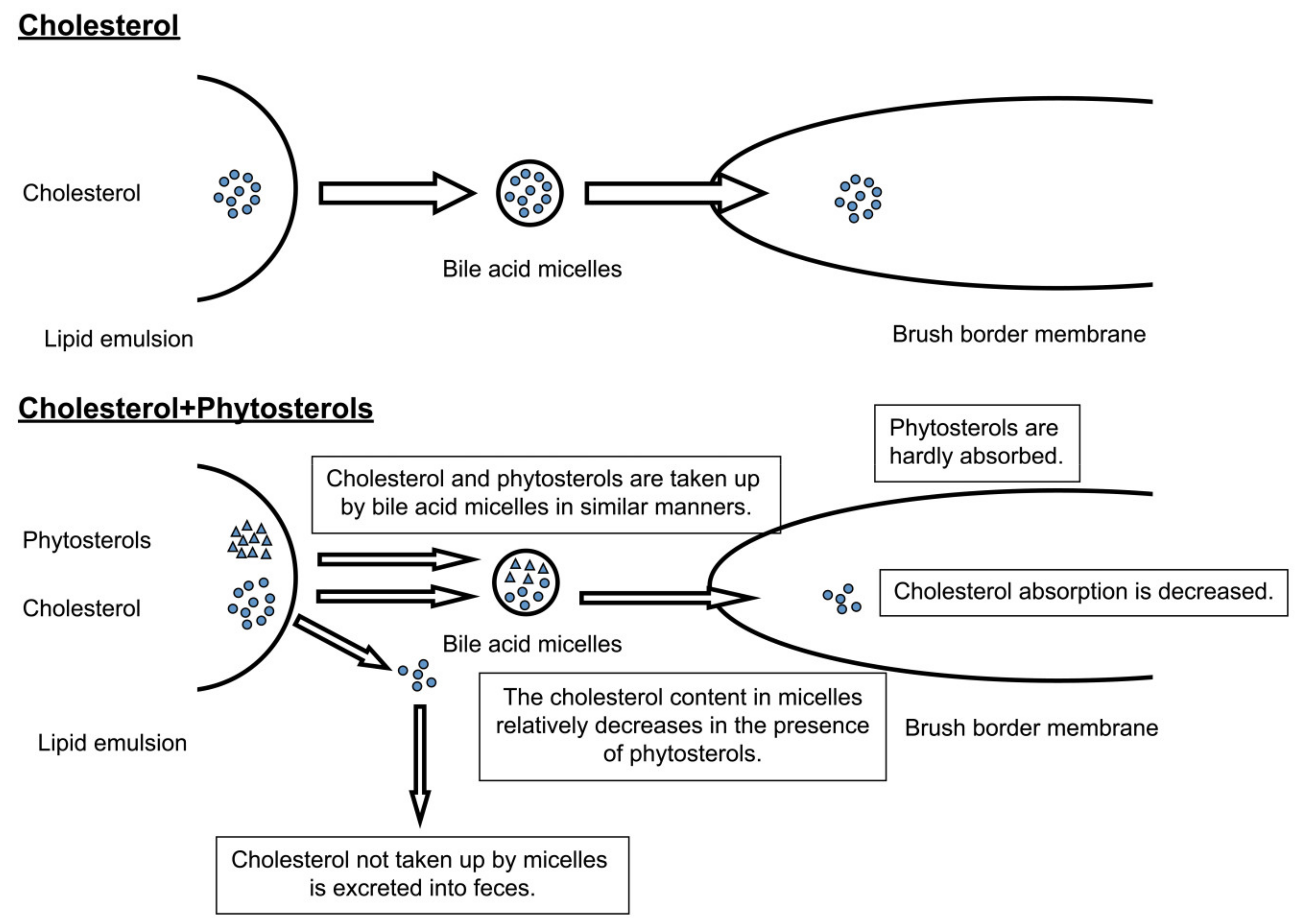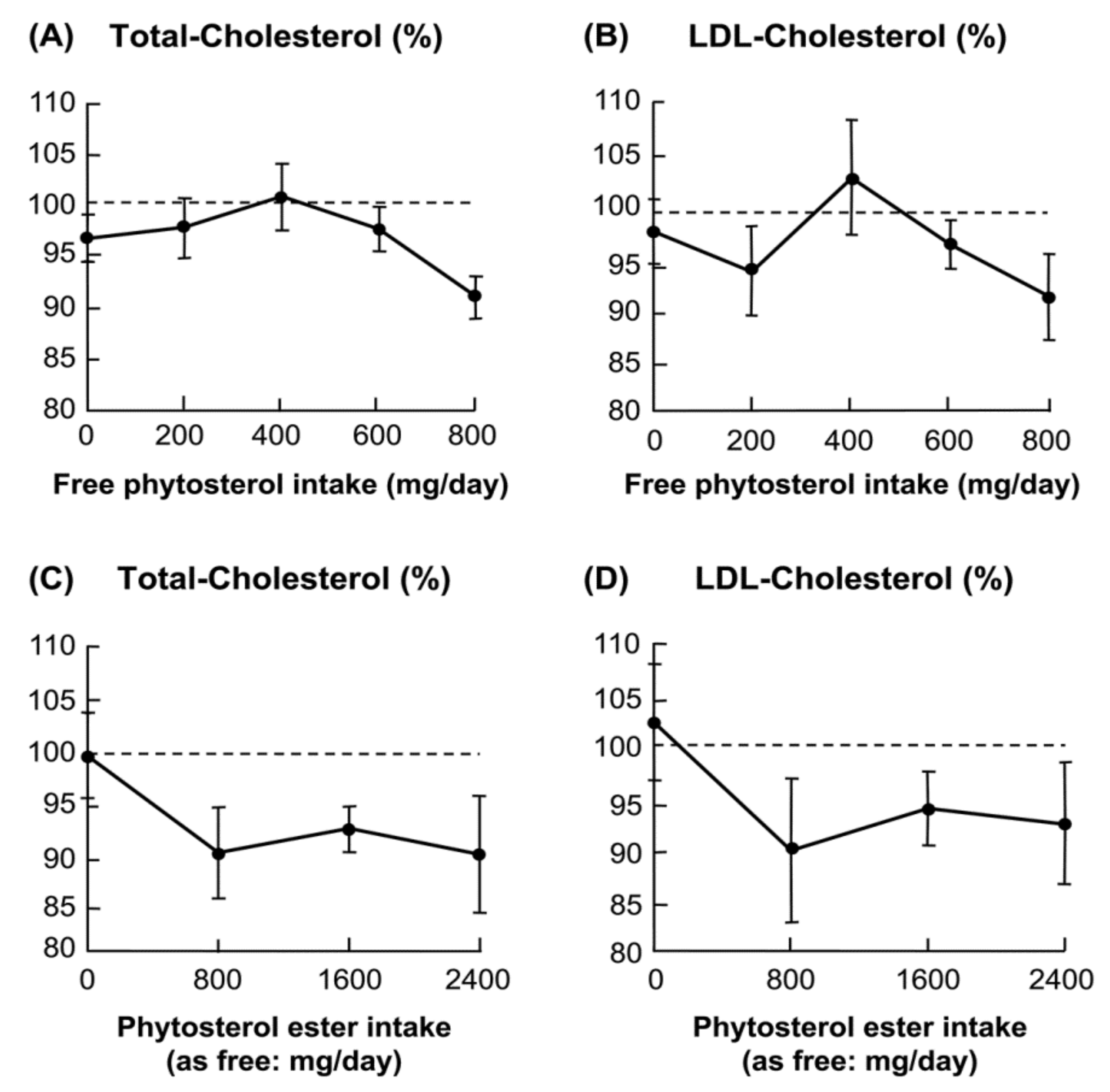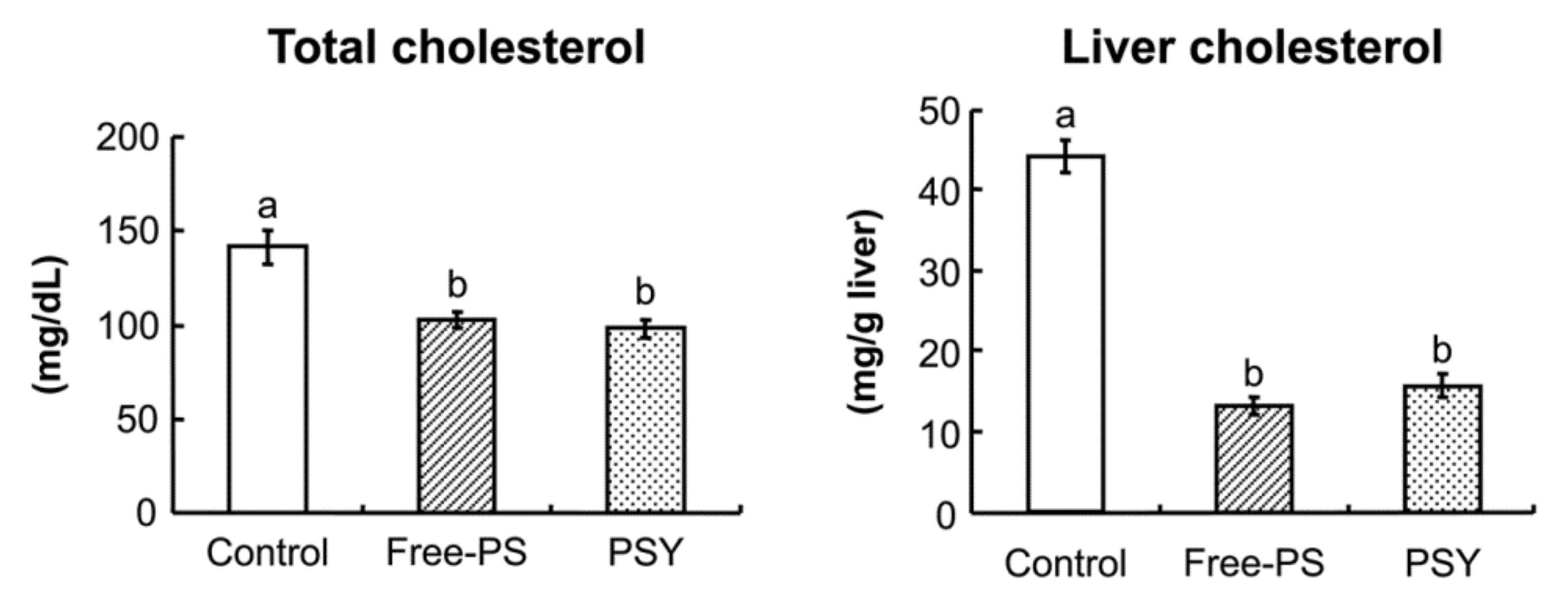Property of Phytosterols and Development of Its Containing Mayonnaise-Type Dressing
Abstract
1. Introduction
2. Phytosterols
3. Consumption of Phytosterols
4. Safety of Phytosterols
5. Serum Cholesterol-Lowering Effect of Phytosterols
6. Mechanisms Underlying Cholesterol Absorption Inhibition by Phytosterols
- Phytosterols compete against cholesterol in micelle formation, resulting in inhibition.
- Phytosterols bind to and inhibit the cholesterol receptor essential for the cholesterol uptake across the microvillus membrane.
- Phytosterols inhibit the intracellular esterification of cholesterol.
7. Minimum Effective Dose of Phytosterols
8. Free Phytosterol-Containing Mayonnaise-Type Dressing Materials
9. Safety of Phytosterol-Containing Mayonnaise-Type Dressing Materials
10. Efficacy of Phytosterol-Containing Mayonnaise-Type Dressing Materials
11. Discussion
| Study | Subjects | Test Mayonnaise | Design Period | Main Outcome (Change% vs. before Intake) |
|---|---|---|---|---|
| Ishizaki, T. (2003) [61] | Normo and Mildly hypercholesterolemia (PSE: n = 26, placebo: n = 29) | Mayonnaise1-type dressing (PSE: 884 mg/15 g as free PS) | RCT 12 weeks | TC: −4.6%, LDL-C: −5.6% |
| Saito, S. (2006) [63] | Normo and Mildly hypercholesterolemia (n = 16–17) | Diacylglycerol based mayonnaise-type drsssing (Free PS: 0–500 mg/15 g) | RCT 4 weeks | 300 mg: TC: −6.0%, LDL-C: −12.1% 400 mg: TC: −7.1%, LDL-C: −11.0% 500 mg: TC: −8.7%, LDL-C: −14.4% |
| Meguro, S. (2001) [64] | Normo and Mildly hypercholesterolemia (n = 12) | Diacylglycerol or triacylglycerol based mayonnaise-type dressing (Free PS: 500 mg/15 g) | Crossover 4 weeks | Triacylglycerol oil base TC, LDL-C: No change Diacylglycerol oil base TC: −4.6%, LDL-C: −8.1% |
| Matsuoka, R. (2004) [33] | Normo and Mildly hypercholesterolemia (Free-PS: n = 23, placebo: n = 23) | Low-energy Mayonnaise-type dressing (Free PS: 823 mg/15 g) | RCT 12 weeks | TC: −4.3%, LDL-C: −9.2% |
| Matsuoka, R. (2005) [59] | Normo and Mildly hypercholesterolemia (Free-PS: n = 30, placebo: n = 31) | Low-energy Mayonnaise-type dressing (Free PS: 885 mg/15 g) | RCT 12 weeks | Total subjcts: TC: −3.4%, LDL-C: −4.7% Mildly hypercholesterolemia: TC: −5.0%, LDL-C: −7.8% |
| Takeda, S. (2008) [60] | Normo and Mildly hypercholesterolemia (Free PS: n = 27, placebo: n = 27) | Low-energy Mayonnaise-type dressing (Free PS: 885 mg/15 g) | RCT 12 weeks | TC: −5.1%, LDL-C: −5.2% |
| Sato, H. (2010) [62] | Normo and Mildly hypercholesterolemia (PSE: n = 45, placebo: n = 35) | Low-energy Mayonnaise-type dressing (PSE: 884 mg/15 g as free PS) | RCT 12 weeks | TC: −5.7%, LDL-C: −6.5% |
12. Conclusions
Funding
Institutional Review Board Statement
Informed Consent Statement
Data Availability Statement
Acknowledgments
Conflicts of Interest
References
- Kimura, T.; Tanaka, T.; Umezu, T.; Ariizumi, M. New technological development for functional mayonnaise. Jpn. J. Food Eng. 2011, 12, 113–115. (In Japanese) [Google Scholar] [CrossRef]
- Matsuoka, R.; Masuda, Y.; Takamiya, M.; Kawamura, M.; Hirayama, S.; Hasegawa, M.; Tohgi, N. Effect of mayonnaise on serum lipid concentrations in hyperlipidemic subjects. J. Jpn. Soc. Clin. Nutr. 2001, 23, 21–25. (In Japanese) [Google Scholar]
- Karupaiah, T.; Chuah, K.A.; Chinna, K.; Matsuoka, R.; Masuda, Y.; Sundram, K.; Sugano, M. Comparison of soybean oil- and palm olein-based mayonnaise on the plasma lipid and lipoprotein profiles in human subjects: A double-blind randomized controlled trial with cross-over design. Lipids Health Dis. 2016, 15, 131. [Google Scholar] [CrossRef]
- Mia, M.A.; Siddiqui, M.N.; Haque, M.S.; Islam, M.N.; Rukunzzaman, M.; Deb, K. Dietary fibre and coronary heart disease. Mymensingh Med. J. 2002, 11, 133–135. [Google Scholar] [PubMed]
- Bell, L.P.; Hectorn, K.J.; Reynolds, H.; Hunninghake, D.B. Cholesterol-lowering effects of soluble-fiber cereals as part of a prudent diet for patients with mild to moderate hypercholesterolemia. Am. J. Clin. Nutr. 1990, 52, 1020–1026. [Google Scholar] [CrossRef] [PubMed]
- Maezaki, Y.; Tsuji, K.; Nakagawa, Y.; Kawai, Y.; Akimoto, M.; Tsugita, T.; Takekawa, W.; Terada, A.; Hara, H.; Mitsuoka, T. Hypocholesterolemic effect of chitosan in adult males. Biosci. Biotechnol. Biochem. 1993, 57, 1439–1444. [Google Scholar] [CrossRef]
- Ikeguchi, M.; Kobayashi, M.; Ariura, Y.; Mitsui, T.; Takagaki, K.; Ishibashi, Y.; Tsuji, K. The effect of AOJIRU drink powder of barley green grasses containing chitosan on the serum lipids and the safety. J. Nutr. Food 2003, 6, 39–50. (In Japanese) [Google Scholar]
- Nishizawa, M.; Iwata, K.; Yamagishi, T.; Tsuji, K. Effect of depolymerized sodium alginate on the serum and liver cholesterol levels in cholesterol-fed rats. J. Home Econ. Jpn. 1997, 48, 695–698. (In Japanese) [Google Scholar]
- Kajimoto, O.; Kajimoto, Y.; Yabune, M.; Nozawa, A.; Nagata, K.; Kakuda, T. Tea catechins reduce serum cholesterol levels in mild and borderline hypercholesterolemia patients. J. Clin. Biochem. Nutr. 2003, 33, 101–111. (In Japanese) [Google Scholar] [CrossRef]
- Tsuzuki, K.; Asao, H.; Ban, S.; Ikematsu, H.; Shionoya, K. Evaluation of the effect of prepared soymilk containing soy protein on serum lipids and the safety of its excessive intake. J. Nutr. Food 2003, 6, 25–38. (In Japanese) [Google Scholar]
- Sirtori, C.R.; Lovati, M.R.; Manzoni, C.; Monetti, M.; Pazzucconi, F.; Gatti, E. Soy and cholesterol reduction: Clinical experience. J. Nutr. 1995, 125 (Suppl. S3), 598S–605S. [Google Scholar] [CrossRef] [PubMed]
- Matsuoka, R.; Usuda, M.; Masuda, Y.; Kunou, M.; Utsunomiya, K. Lactic-fermented egg white reduced serum cholesterol concentrations in mildly hypercholesterolemic Japanese men: A double-blind, parallel-arm design. Lipids Health Dis. 2017, 16, 101. [Google Scholar] [CrossRef] [PubMed]
- Matsuoka, R.; Kimura, M.; Muto, A.; Masuda, Y.; Sato, M.; Imaizumi, K. Mechanism for the cholesterol-lowering action of egg white protein in rats. Biosci. Biotechnol. Biochem. 2008, 72, 1506–1512. [Google Scholar] [CrossRef] [PubMed]
- Matsuoka, R.; Masuda, Y.; Takeuchi, A.; Marushima, R.; Onuki, M. Minimal effective dose of plant sterol on serum cholesterol concentration in Japanese subjects and safety evaluation of plant sterol supplemented in mayonnaise. J. Oleo Sci. 2004, 53, 17–27. (In Japanese) [Google Scholar] [CrossRef]
- Matsuoka, R.; Muto, A.; Kimura, M.; Hoshina, R.; Wakamatsu, T.; Masuda, Y. Cholesterol-lowering activity of plant sterol-egg yolk lipoprotein complex in rats. J. Oleo Sci. 2008, 57, 309–314. [Google Scholar] [CrossRef]
- Ikeda, I. Studies on mechanism of sterols absorption. Nippon Nougeikagaku Kaishi 1991, 65, 1729–1734. (In Japanese) [Google Scholar] [CrossRef]
- Ohno, Y.; Hara, I. New aspects on nutrition: (2) sterol. J. Jpn. Oil Chem. Soc. 1981, 30, 592–598. (In Japanese) [Google Scholar] [CrossRef][Green Version]
- Hidaka, K.; Yoshida, K.; Izaki, Y.; Toda, K. Vitamin E, cholesterol and fatty acids in foods determination of their content and Estimation of daily intake. J. Jpn. Soc. Nutr. Food Sci. 1986, 39, 308–320. (In Japanese) [Google Scholar] [CrossRef]
- Nakajima, K.; Ikeda, I.; Fuchigami, K.; Shiroishi, Y.; Sugano, M.; Yasue, R.; Matsumoto, M. Nutritional composition of university set meal—Especially sterol and dietary fiber contents. Jap. J. Clin. Nutr. 1981, 58, 263–268. (In Japanese) [Google Scholar]
- Hirai, K.; Shimazu, C.; Takezoe, R.; Ozeki, Y. Cholesterol, phytosterol and polyunsaturated fatty acid levels in 1982 and 1957 Japanese diets. J. Nutr. Sci. Vitaminol. 1986, 32, 363–372. [Google Scholar] [CrossRef]
- Ishinaga, M.; Mochizuki, T.; Ueda, A.; Ichi, I.; Nanatsue, M.; Oda, M.; Kishida, N. Daily intakes of fatty acids, cholesterol and plant sterols by obese and non-obese school children. J. Jpn. Soc. Nutr. Food Sci. 2001, 54, 291–296. (In Japanese) [Google Scholar] [CrossRef]
- Nair, P.P.; Turjman, N.; Kessie, G.; Calkins, B.; Goodman, G.T.; Davidovitz, H.; Nimmagadda, G. Diet, nutrition intake, and metabolism in populations at high and low risk for colon cancer. Dietary cholesterol, β-sitosterol, and stigmasterol. Am. J. Clin. Nutr. 1984, 40 (Suppl. S4), 927–930. [Google Scholar] [CrossRef]
- Morton, G.M.; Lee, S.M.; Buss, D.H.; Lawrance, P. Intakes and major dietary sources of cholesterol and phytosterols in the British diet. J. Hum. Nutr. Diet. 1995, 8, 429–440. [Google Scholar] [CrossRef]
- Normén, A.L.; Brants, H.A.M.; Voorrips, L.E.; Andersson, H.A.; van den Brandt, P.A.; Goldbohm, R.A. Plant sterol intakes and colotectal cancer risk in the Netherlands cohort study on diet and cancer. Am. J. Clin. Nutr. 2001, 74, 141–148. [Google Scholar] [CrossRef] [PubMed]
- Japan Pharmaceutical Information Center. Soy unsaponifiable. Pharm. Mon. 1974, 16, 77–78. (In Japanese) [Google Scholar]
- Hepburn, P.A.; Horner, S.A.; Smith, M. Safety evaluation of phytosterol esters. Part 2. Subchronic 90-day oral toxicity study on phytosterol esters—A novel functional food. Food Chem. Toxicol. 1999, 37, 521–532. [Google Scholar] [CrossRef]
- Shipley, R.E.; Pfeiffer, R.R.; Marsh, M.M.; Anderson, R.C. Sitosterol feeding—Chronic animal and clinical toxicology and tissue analysis. Circ. Res. 1958, 6, 373–382. [Google Scholar] [CrossRef]
- Wolfreys, A.M.; Hepburn, P.A. Safety evaluation of phytosterol esters. Part 7. Assesment of mutagenic activity of phytosterols, phytosterol esters and the cholesterol derivative, 4-cholesten-3–one. Food Chem. Toxicol. 2002, 40, 461–470. [Google Scholar] [CrossRef]
- Waalkens-Berendsen, D.H.; Wolterbeek, A.P.M.; Wijnands, M.V.W.; Richold, M.; Hepburn, P.A. Safety evaluation of phytosterol esters. Part 3. Two-generation reproduction study in rats with phytosterol ester—A novel functional food. Food Chem. Toxicol. 1999, 37, 683–696. [Google Scholar] [CrossRef]
- Baker, V.A.; Hepburn, P.A.; Kennedy, S.J.; Jones, P.A.; Lea, L.J.; Sumpter, J.P.; Ashby, J. Safety evaluation of phytosterol esters. Part 1. Assessment of oestrogenicity using a combination of in vivo and in vitro assays. Food Chem. Toxicol. 1999, 37, 13–22. [Google Scholar] [CrossRef]
- Ayesh, R.; Weststrate, J.A.; Drewitt, P.N.; Hepburn, P.A. Safety evaluation of phytosterol esters. Part 5. Feacal short-chain fatty acid and microfloracontent, feacal Bacterial enzyme activity and serum female sex hormones in healthy normolipidemic volumteers consuming a controlled diet either with or without a phytosterol ester-enriched margarine. Food Chem. Toxicol. 1999, 37, 1127–1138. [Google Scholar] [CrossRef]
- Davidson, M.H.; Maki, K.C.; Umporowicz, D.M.; Ingram, K.A.; Dicklin, M.R.; Schaefer, E.; Lane, R.W.; McNamara, J.R.; Ribaya-Mercado, J.D.; Perrone, G.; et al. Safety and tolerability of esterified phytosterols administered in reduced-fat spread and salad dressing to healthy adult men and women. J. Am. Coll. Nutr. 2001, 20, 307–319. [Google Scholar] [CrossRef] [PubMed]
- Matsuoka, R.; Masuda, Y.; Takeuchi, A.; Marushima, R.; Hasegawa, M.; Sakamoto, A.; Hirata, H.; Kajimoto, O.; Homma, Y. A double-blind, placebo-controlled study on the effects of mayonnaise containing free plant sterol on serum cholesterol concentration; Safety evaluation for normocholesterolemic and mildly hypercholesterolemic Japanese subjects. J. Oleo Sci. 2004, 53, 79–88. (In Japanese) [Google Scholar] [CrossRef][Green Version]
- Gylling, H.; Miettinen, T.A. Cholesterol reduction by different plant sterol mixtures and with variable fat intake. Metabolism 1999, 48, 575–580. [Google Scholar] [CrossRef]
- Tammi, A.; Rönnemaa, T.; Gylling, H.; Rask-Nissilä, L.; Viikari, J.; Tuominen, J.; Pulkki, K.; Simell, O. Plant stanol ester margarine lowers serum total and low-density lipoprotein cholesterol concentrations of healthy children: The STRIP project. Special Turku Coronary Risk Factors Intervention Project. J. Pediatr. 2000, 136, 503–510. [Google Scholar] [CrossRef]
- Hallikainen, M.A.; Uusitupa, M.I.J. Effects of 2 low-fat stanol ester-containing margarines on serum cholesterol concentrations as part of a low-fat diet in hypercholesteroleic subjects. Am. J. Clin. Nutr. 1999, 69, 403–410. [Google Scholar] [CrossRef]
- Hendriks, H.F.J.; Weststrate, J.A.; van Vliet, T.; Meijer, G.W. Spreads enriched with three different levels of vagetable oil sterols and degree of cholesterol lowering in normocholesterolemic and mildly hypercholesterolemic subjects. Eur. J. Clin. Nutr. 1999, 53, 319–327. [Google Scholar] [CrossRef]
- Christiansen, L.I.; Lähteenmäki, P.L.A.; Mannelin, M.R.; Seppänen-Laakso, T.E.; Hiltunen, R.V.K.; Yliruusi, J.K. Cholesterol-lowering effect of spreads enriched with microcrystallin plant sterols in hypercholesterolemic subjects. Eur. J. Nutr. 2001, 40, 66–73. [Google Scholar] [CrossRef] [PubMed]
- Volpe, R.; Niittynen, L.; Korpela, R.; Sirtori, C.; Bucci, A.; Fraone, N.; Pazzucconi, F. Effects of yoghurt enriched with plant sterols on serum lipids in patients with moderate hypercholesterolaemia. Br. J. Nutr. 2001, 86, 233–239. [Google Scholar] [CrossRef]
- Hidaka, H. Sitoterolemia. Nihon Rinsho 2001, 59 (Suppl. S3), 344–347. (In Japanese) [Google Scholar]
- Salen, G.; Kwiterovich, P.O.; Shefer, S.; Tint, G.S.; Horak, I.; Shore, V.; Dayal, B.; Horak, E. Increased plasma cholesterol and 5α-saturated plant sterol derivatives in subjects with sitosterolemia and xanthomatosis. J. Lipid Res. 1985, 26, 203–209. [Google Scholar] [CrossRef]
- Ikeda, I.; Sugano, M. Inhibition of cholesterol absorption by plant sterols for mass intervention. Curr. Opin. Lipidol. 1998, 9, 527–531. [Google Scholar] [CrossRef] [PubMed]
- Heinemann, T.; Axtmann, G.; von Bergmann, K. Comparison of intestinal absorption of cholesterol with different plant sterols in man. Eur. J. Clin. Investig. 1993, 23, 827–831. [Google Scholar] [CrossRef] [PubMed]
- Ostlund, R.E. Phytosterols in human nutrition. Annu. Rev. Nutr. 2002, 22, 533–549. [Google Scholar] [CrossRef] [PubMed]
- Subbiah, M.T.R.; Kuksis, A. Differences in metabolism of cholesterol and sitosterol following intravenous injection in rats. Biochim. Biophys. Acta 1973, 306, 95–105. [Google Scholar] [CrossRef]
- Sugano, M.; Morioka, H.; Ikeda, I. A comparison of hypocholesterolemic activity of β-sitosterol and β-sitostanol in rats. J. Nutr. 1977, 107, 2011–2019. [Google Scholar] [CrossRef]
- Uchida, K.; Mizuno, H.; Hirota, K.; Takeda, K.; Takeuchi, N.; Ishikawa, Y. Effects of spinasterol and sitosterol on plasma and liver cholesterol levels and biliary and fecal sterol and bile acid excretions in mice. Jpn. J. Pharmacol. 1983, 33, 103–112. (In Japanese) [Google Scholar] [CrossRef]
- Ntanios, F.Y.; Jones, P.J.H. Effects of variable dietary sitostanol concentrations on plasma lipid profile and phytosterol metabolism in hamsters. Biochim. Biophys. Acta 1998, 1390, 237–244. [Google Scholar] [CrossRef]
- Ikeda, I.; Tanaka, K.; Sugano, M.; Vahouny, G.V.; Gallo, L.L. Inhibition of cholesterol absorption in rats by plant sterols. J. Lipid Res. 1988, 29, 1573–1582. [Google Scholar] [CrossRef]
- Ogino, Y.; Hayashi, N.; Kimura, M.; Takizawa, K.; Matsuoka, R.; Masuda, Y.; Hasegawa, M. Effect of dietary plant sterols and/or mayonnaise supplementation on lipid metabolism in rats. J. Oleo Sci. 2004, 53, 67–72. (In Japanese) [Google Scholar] [CrossRef][Green Version]
- Ooyama, K.; Seki, S.; Hidaka, I.; Yoshino, H.; Tsuji, H.; Taguchi, N.; Nakajima, S.; Kondo, K. Effects of plant sterol-containing oil on postprandial serum lipids. Jpn. J. Nutr. Diet 2001, 59, 271–276. (In Japanese) [Google Scholar] [CrossRef]
- Ikeda, I.; Sugano, M. Some aspects of mechanism of inhibition of cholesterol absorption by β-sitosterol. Biochim. Biophys. Acta 1983, 732, 651–658. [Google Scholar] [CrossRef]
- Li, X.; Xin, Y.; Mo, Y.; Marozik, P.; He, T.; Guo, H. The Bioavailability and Biological Activities of Phytosterols as Modulators of Cholesterol Metabolism. Molecules 2022, 27, 523. [Google Scholar] [CrossRef] [PubMed]
- Cedó, L.; Farràs, M.; Lee-Rueckert, M.; Escolà-Gil, J.C. Molecular Insights into the Mechanisms Underlying the Cholesterol- Lowering Effects of Phytosterols. Curr. Med. Chem. 2019, 26, 6704–6723. [Google Scholar] [CrossRef] [PubMed]
- Pelletier, X.; Belbraouet, S.; Mirabel, D.; Mordret, F.; Perrin, J.L.; Pages, X.; Debry, G. A diet moderatery enriched in phytosterols lowers plasma cholesterol concentrations in normocholesterolemic humans. Ann. Nutr. Metab. 1995, 39, 291–295. [Google Scholar] [CrossRef] [PubMed]
- Sierksma, A.; Weststrate, J.A.; Meijer, G.W. Spreads enriched with plant sterols, either esterified 4,4-dimethylsterols of free 4-desmosterols, and plasma total- and LDL-cholesterol concentrations. Br. J. Nutr. 1999, 82, 273–282. [Google Scholar] [CrossRef]
- Vanhanen, H.T.; Miettinen, T.A. Effects of unsaturated and saturated dietary plant sterols on their serum contents. Clin. Chim. Acta 1992, 205, 97–107. [Google Scholar] [CrossRef]
- Saito, S.; Ikeda, I.; Sugano, M. Effect of plant sterols and stanols on blood cholesterol level: Clinical evidence of minimum effective dose. J. Jpn. Soc. Nutr. Food Sci. 2002, 55, 177–189. (In Japanese) [Google Scholar] [CrossRef]
- Matsuoka, R.; Marushima, R.; Kurokawa, M.; Masuda, Y.; Hasegawa, M.; Takahama, M.; Onuki, M.; Sugano, M. Effect of mayonnaise containing plant sterol in Japanese male subjects—Safety evaluation of long-term intake and clinical benefit for serum lipid concentrations. J. Metab. Clin. Nutr. 2005, 8, 139–148. (In Japanese) [Google Scholar]
- Takeda, S.; Masuda, Y.; Kurokawa, M.; Matsuoka, R.; Marushima, R.; Hasegawa, M.; Homma, Y. Effects of mayonnaise containing plant sterol on blood cholesterol in borderline or mildly hypercholesterolemic Japanese subjects. Ningen Dock 2007, 21, 29–34. [Google Scholar]
- Ishizaki, T.; Wakabayashi, M.; Tanimoto, H.; Shima, A.; Yabune, M.; Kajimoto, O.; Itakura, H. Effects of long-term intake of mayonnaise containing phytosterolester on blood cholesterol concentration in Japanese with borderline or mild cholesterolemia. J. Clin. Biochem. Nutr. 2003, 33, 75–82. [Google Scholar] [CrossRef][Green Version]
- Sato, H.; Chiba, Y.; Fujimura, M.; Kondo, N.; Komai, M. Studies to confirm and serum low-density lipoprotein (LDL) cholesterol level-lowering effect of low-calorie mayonnaise supplemented with plant sterol esters. Jpn. J. Compl. Altern. Med. 2010, 7, 75–82. [Google Scholar]
- Saito, S.; Takeshita, M.; Tomonobu, K.; Kudo, N.; Shiiba, D.; Hase, T.; Tokimitsu, I.; Yasukawa, T. Dose-dependent cholesterol-lowering effect of a mayonnaise-type product with a main component of diacylglycerol-containing plant sterol esters. Nutrition 2006, 22, 174–178. [Google Scholar] [CrossRef] [PubMed]
- Meguro, S.; Higashi, K.; Hase, T.; Honda, Y.; Otsuka, A.; Tokimitsu, I.; Itakura, H. Solubilization of phytosterols in diacylglycerol versus triacylglycerol improves the serum cholesterol-lowering effect. Eur. J. Clin. Nutr. 2001, 55, 513–517. [Google Scholar] [CrossRef]
- Miettinen, T.A.; Puska, P.; Gylling, H.; Vanhanen, H.; Vartiainen, E. Reduction of serum cholesterol with sitostanol-ester margarine in a mildly hypercholesterolemic population. N. Engl. J. Med. 1995, 333, 1308–1312. [Google Scholar] [CrossRef]
- Homma, Y.; Ishikawa, T.; Tateno, M.; Mitaniyama, A.; Sugano, M. Cholesterol- and apolipoprotein-lowing effect of plant stanol ester in healthy Japanese men and women. J. Jpn. Soc. Nutr. Food Sci. 2000, 53, 155–162. (In Japanese) [Google Scholar] [CrossRef]
- Goto, N.; Mori, H.; Katsuragi, Y.; Toi, T.; Yasukawa, T.; Shimasaki, H. Effects of diacylglycerol containing phytosterol on reducing blood cholesterol level. J. Jpn. Oil Chem. Soc. 1999, 48, 235–240, 260. [Google Scholar] [CrossRef]
- Ho, X.L.; Liu, J.J.; Loke, W.M. Plant sterol-enriched soy milk consumption modulates 5-lipoxygenase, 12-lipoxygenase, and myeloperoxidase activities in healthy adults—A randomized-controlled trial. Free Radic. Res. 2016, 50, 1396–1407. [Google Scholar] [CrossRef]
- Chau, Y.P.; Cheng, Y.C.; Sing, C.W.; Tsoi, M.F.; Cheng, V.K.; Lee, G.K.; Cheung, C.L.; Cheung, B.M.Y. The lipid-lowering effect of once-daily soya drink fortified with phytosterols in normocholesterolaemic Chinese: A double-blind randomized controlled trial. Eur. J. Nutr. 2020, 59, 2739–2746. [Google Scholar] [CrossRef]
- Cheung, C.L.; Ho, D.K.; Sing, C.W.; Tsoi, M.F.; Cheng, V.K.; Lee, G.K.; Ho, Y.N.; Cheung, B.M. Randomized controlled trial of the effect of phytosterols-enriched low-fat milk on lipid profile in Chinese. Sci. Rep. 2017, 7, 41084. [Google Scholar] [CrossRef]
- Blanco-Morales, V.; López-García, G.; Cilla, A.; Garcia-Llatas, G.; Barberá, R.; Lagarda, M.J.; Sánchez-Siles, L.M.; Alegría, A. The impact of galactooligosaccharides on the bioaccessibility of sterols in a plant sterol-enriched beverage: Adaptation of the harmonized INFOGEST digestion method. Food Funct. 2018, 9, 2080–2089. [Google Scholar] [CrossRef] [PubMed]
- Devaraj, S.; Jialal, I.; Vega-López, S. Plant sterol-fortified orange juice effectively lowers cholesterol levels in mildly hypercholesterolemic healthy individuals. Arterioscler. Thromb. Vasc. Biol. 2004, 24, e25–e28. [Google Scholar] [CrossRef] [PubMed]
- Li, N.Y.; Li, K.; Qi, Z.; Demonty, I.; Gordon, M.; Francis, L.; Molhuizen, H.O.; Neal, B.C. Plant sterol-enriched milk tea decreases blood cholesterol concentrations in Chinese adults: A randomized controlled trial. Br. J. Nutr. 2007, 98, 978–983. [Google Scholar] [CrossRef] [PubMed][Green Version]
- Kurokawa, M.; Masuda, Y.; Noda, M.; Marushima, R.; Usuda, M.; Takeda, S.; Hasegawa, M.; Homma, Y.; Sugano, M. Minimal effective dose on serum cholesterol concentration and the safety evaluation of dressing containing plant sterol in Japanese subjects. J. Oleo Sci. 2008, 57, 23–33. (In Japanese) [Google Scholar] [CrossRef][Green Version]
- Kurokawa, M.; Masuda, Y.; Noda, M.; Usuda, M.; Takeda, S.; Hasegawa, M.; Homma, Y.; Sugano, M. Effects of dressing containing plant sterol on serum cholesterol concentration and the safety evaluation in borderline or mildly hypercholesterolemic Japanese subjects. J. Oleo Sci. 2008, 57, 35–45. (In Japanese) [Google Scholar] [CrossRef][Green Version]
- Elisa, T.; Miriana, S.; Davide, P.; Michele, T.; Ersilia, L.; Lara, T.; Angelo, B. Efficacy of Plant Sterol-Enriched Food for Primary Prevention and Treatment of Hypercholesterolemia: A Systematic Literature Review. Foods 2022, 11, 839. [Google Scholar] [CrossRef]
- Zhang, R.; Han, Y.; McClements, D.J.; Xu, D.; Chen, S. Production, Characterization, Delivery, and Cholesterol-Lowering Mechanism of Phytosterols: A Review. J. Agric. Food. Chem. 2022, 70, 2483–2494. [Google Scholar] [CrossRef]
- Makhmudova, U.; Schulze, P.C.; Lütjohann, D.; Weingärtner, O. Phytosterols and Cardiovascular Disease. Curr. Atheroscler. Rep. 2021, 23, 68. [Google Scholar] [CrossRef]
- Poli, A.; Marangoni, F.; Corsini, A.; Manzato, E.; Marrocco, W.; Martini, D.; Medea, G.; Visioli, F. Phytosterols, Cholesterol Control, and Cardiovascular Disease. Nutrient 2021, 13, 2810. [Google Scholar] [CrossRef]
- Kaur, R.; Myrie, S.B. Association of Dietary Phytosterols with Cardiovascular Disease Biomarkers in Humans. Lipids 2020, 55, 569–584. [Google Scholar] [CrossRef]
- Köhler, J.; Teupser, D.; Elsässer, A.; Weingärtner, O. Plant sterol enriched functional food and atherosclerosis. Br. J. Pharmacol. 2017, 174, 1281–1289. [Google Scholar] [CrossRef] [PubMed]
- Fumeron, F.; Bard, J.M.; Lecerf, J.M. Interindividual variability in the cholesterol-lowering effect of supplementation with plant sterols or stanols. Nutr. Rev. 2017, 75, 134–145. [Google Scholar] [CrossRef] [PubMed]
- Prasad, M.; Jayaraman, S.; Eladl, M.A.; El-Sherbiny, M.; Abdelrahman, M.A.E.; Veeraraghavan, V.P.; Vengadassalapathy, S.; Umapathy, V.R.; Jaffer Hussain, S.F.; Krishnamoorthy, K.; et al. A Comprehensive Review on Therapeutic Perspectives of Phytosterols in Insulin Resistance: A Mechanistic Approach. Molecules 2022, 27, 1595. [Google Scholar] [CrossRef] [PubMed]
- Jayaraman, S.; Roy, A.; Vengadassalapathy, S.; Sekar, R.; Veeraraghavan, V.P.; Rajagopal, P.; Rengasamy, G.; Mukherjee, R.; Sekar, D.; Manjunathan, R. An Overview on the Therapeutic Function of Foods Enriched with Plant Sterols in Diabetes Management. Antioxidants 2021, 10, 1903. [Google Scholar] [CrossRef]
- Vilahur, G.; Ben-Aicha, S.; Diaz-Riera, E.; Badimon, L.; Padró, T. Phytosterols and Inflammation. Curr. Med. Chem. 2019, 26, 6724–6734. [Google Scholar] [CrossRef] [PubMed]




| Energy | (kcal) | 48 |
| Protein | (g) | 0.3 |
| Fat # | (g) | 4.9 |
| Carbohydrate | (g) | 0.5 |
| Sodium | (mg) | 165 |
| Cholesterol | (mg) | 22 |
| Plant sterol | (mg) | 885 |
| Group | Week | Statistical | +2 Week | ||||
|---|---|---|---|---|---|---|---|
| 0 | 4 | 8 | 12 | Significance a | (14 Week) | ||
| TC (mg/dL) | PS (−) | 247 ± 6 | 250 ± 6 | 246 ± 5 | 259 ± 7 | NS | 243 ± 5 † |
| PS (+) | 244 ± 7 | 232 ± 7 *,# | 229 ± 5 *,# | 230 ± 6 *,# | p = 0.009 | 223 ± 5 # | |
| LDL-C (mg/dL) | PS (−) | 159 ± 5 | 157 ± 6 | 154 ± 5 | 164 ± 7 | NS | 151 ± 6 † |
| PS (+) | 156 ± 5 | 145 ± 5 * | 138 ± 4 *,# | 145 ± 4 *,# | p < 0.001 | 139 ± 4 | |
| Apo B (mg/dL) | PS (−) | 127 ± 4 | 121 ± 4 | 123 ± 4 | 127 ± 5 | NS | 119 ± 4 † |
| PS (+) | 121 ± 4 | 111 ± 4 * | 111 ± 3 *,# | 111 ± 4 *,# | p < 0.001 | 107 ± 3 | |
Publisher’s Note: MDPI stays neutral with regard to jurisdictional claims in published maps and institutional affiliations. |
© 2022 by the author. Licensee MDPI, Basel, Switzerland. This article is an open access article distributed under the terms and conditions of the Creative Commons Attribution (CC BY) license (https://creativecommons.org/licenses/by/4.0/).
Share and Cite
Matsuoka, R. Property of Phytosterols and Development of Its Containing Mayonnaise-Type Dressing. Foods 2022, 11, 1141. https://doi.org/10.3390/foods11081141
Matsuoka R. Property of Phytosterols and Development of Its Containing Mayonnaise-Type Dressing. Foods. 2022; 11(8):1141. https://doi.org/10.3390/foods11081141
Chicago/Turabian StyleMatsuoka, Ryosuke. 2022. "Property of Phytosterols and Development of Its Containing Mayonnaise-Type Dressing" Foods 11, no. 8: 1141. https://doi.org/10.3390/foods11081141
APA StyleMatsuoka, R. (2022). Property of Phytosterols and Development of Its Containing Mayonnaise-Type Dressing. Foods, 11(8), 1141. https://doi.org/10.3390/foods11081141






